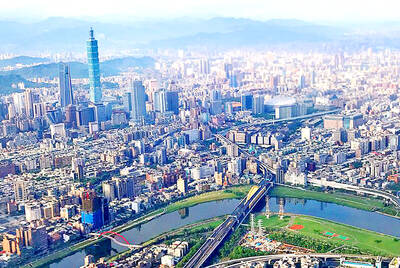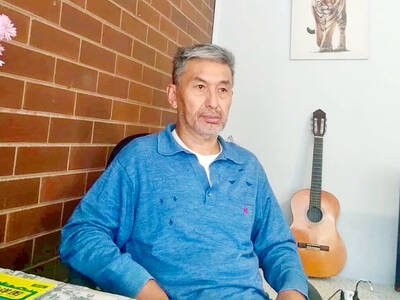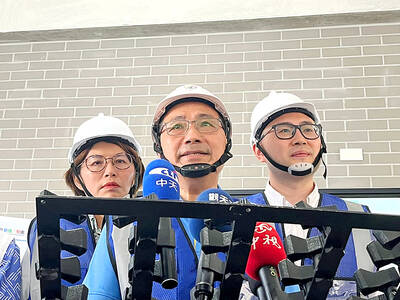Lawmakers are engaged in a number of actions in preparation for a referendum on the highly controversial Fourth Nuclear Power Plant in Gongliao District (貢寮), New Taipei City (新北市), which is likely to be held in the summer.
Democratic Progressive Party (DPP) Legislator Yeh Yi-jin (葉宜津) has scheduled a negotiation meeting on Tuesday to discuss an amendment to the Referendum Act (公民投票法), which calls for an amendment to the threshold required for a referendum’s proposal to be passed.
The amendment seeks to change rules that require turnout of at least half of the electorate for a national referendum to be valid, with an absolute majority of 51 percent of votes required for a proposal to be approved.
These rules have been criticized by the DPP and a number of civic groups as leading to “bird cage” referendums, meaning that the law’s excessively high threshold means that referendums are designed to fail.
Yeh’s amendment, supported by the DPP, proposes reducing the turnout requirement, meaning that referendum results would be more likely to be decided by majority voting.
Under Yeh’s proposal, for a referendum to pass, the “yes” votes must outnumber the “no” votes and they must account for at least one-fourth of the electorate. A referendum would fail if less than one-fourth of eligible voters vote in favor of the proposal, or if the “no” votes exceed the “yes” votes.
Chinese Nationalist Party (KMT) caucus whip Ling Hung-chih (林鴻池) said his party was willing to discuss the issue with the opposition, but was opposed to reducing current thresholds.
The KMT plans to submit its proposal for a referendum on the Fourth Nuclear Power Plant to the legislature this week, which, if approved, would lead to a referendum within six months.
Lin said that a proposal is being drafted by the party’s Policy Committee to ask people: “Do you support halting construction of the Fourth Nuclear Power Plant?”
The KMT has said that the proposal will not be submitted under the name of the caucus or caucus whips, apparently in order to avoid the awkwardness that the KMT caucus and the government might face in arguing different cases during referendum debates.
KMT legislative caucus whip Lai Shyh-bao (賴士葆) on Friday suggested that the proposal be submitted by KMT lawmakers who were of the view that construction of the Fourth Nuclear Power Plant should be halted and it should not become operational.
KMT Legislator Ting Shou-chung (丁守中), the most vocal opponent of the Fourth Nuclear Power Plant in the party, disagreed with Lai’s proposal and said it seemed “odd” that referendum debates could see lawmakers from the ruling party face off against the government.
If the referendum question was to be phrased in such a way as to ask people if they support halting construction of the Fourth Nuclear Power Plant, then the referendum proposal should be submitted by either the DPP or by anti-nuclear groups, Ting said.
Meanwhile, DPP Chairman Su Tseng-chang (蘇貞昌) yesterday said his party will confront the government face-to-face on the issue even though the KMT government is employing a variety of tactics to continue with its nuclear policy by manipulation of the proposed referendum.
Su added that the anti-nuclear campaign is not a fight between political parties, but one of mothers for their children and Taiwanese for a safe, non-nuclear homeland.
“We hope everyone will stand up and take this chance to save our environment,” he said.
Additional reporting by Rich Chang

Taipei has once again made it to the top 100 in Oxford Economics’ Global Cities Index 2025 report, moving up five places from last year to 60. The annual index, which was published last month, evaluated 1,000 of the most populated metropolises based on five indices — economics, human capital, quality of life, environment and governance. New York maintained its top spot this year, placing first in the economics index thanks to the strength of its vibrant financial industry and economic stability. Taipei ranked 263rd in economics, 44th in human capital, 15th in quality of life, 284th for environment and 75th in governance,

Greenpeace yesterday said that it is to appeal a decision last month by the Taipei High Administrative Court to dismiss its 2021 lawsuit against the Ministry of Economic Affairs over “loose” regulations governing major corporate electricity consumers. The climate-related lawsuit — the first of its kind in Taiwan — sought to require the government to enforce higher green energy thresholds on major corporations to reduce emissions in light of climate change and an uptick in extreme weather. The suit, filed by Greenpeace East Asia, the Environmental Jurists Association and four individual plaintiffs, was dismissed on May 8 following four years of litigation. The

A former officer in China’s People’s Liberation Army (PLA) who witnessed the aftermath of the 1989 Tiananmen Square massacre has warned that Taiwan could face a similar fate if China attempts to unify the country by force. Li Xiaoming (李曉明), who was deployed to Beijing as a junior officer during the crackdown, said Taiwanese people should study the massacre carefully, because it offers a glimpse of what Beijing is willing to do to suppress dissent. “What happened in Tiananmen Square could happen in Taiwan too,” Li told CNA in a May 22 interview, ahead of the massacre’s 36th anniversary. “If Taiwanese students or

The New Taipei City Government would assist relatives of those killed or injured in last month’s car-ramming incident in Sansia District (三峽) to secure compensation, Mayor Hou You-yi (侯友宜) said yesterday, two days after the driver died in a hospital. “The city government will do its best to help the relatives of the car crash incident seek compensation,” Hou said. The mayor also said that the city’s Legal Affairs, Education and Social Welfare departments have established a joint mechanism to “provide coordinated assistance” to victims and their families. Three people were killed and 12 injured when a car plowed into schoolchildren and their